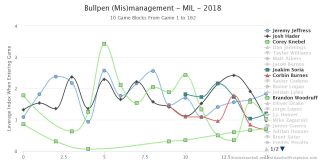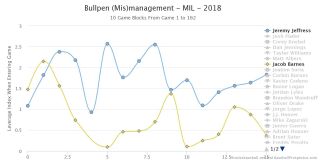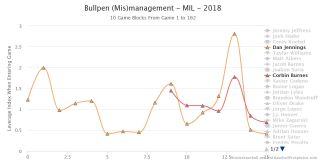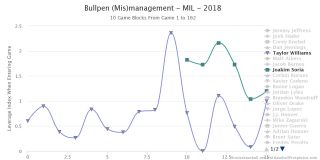|
The big story of the National League Division Series -- and what could soon be the big story of the National League Championship Series -- was the Milwaukee Brewers' bullpen. Their starting rotation contributed just 29 outs over three games; the other 55 outs were converted by six members of the bullpen, including Brandon Woodruff, who started a pre-planned "bullpen day" in Game 1 against the Colorado Rockies. Only one of the six (closer Jeremy Jeffress) allowed any runs, and collectively they had an 0.98 ERA, with 12.3 strikeouts per nine innings and an 0.65 WHIP -- basically, Eric Gagne's Cy Young 2003 season. The Rockies had one of the worst offensive performances in postseason history; the fight was so one-sided, it's hard to imagine any team scoring against that bullpen. But the story of the Brewers' bullpen is, like most bullpen stories, a lot wilder than what they did over the course of one week. More than any other part of baseball -- or any other part of a baseball team -- the construction of a bullpen over the course of a season is filled with twists, of good pitchers disappearing and bad pitchers becoming unhittable, of near-constant churn in the high-leverage innings and, ultimately, a great big leap of faith when the games count the most. With the exception of Josh Hader -- whose story of going from "pretty good reliever" to "arguably the best reliever in baseball this year" is fairly blasé, by reliever-narrative standards -- every unhittable Brewers reliever you saw last week could very, very easily have not appeared in that series at all. An entirely different Brewers bullpen could have pitched against Colorado instead. Most likely, a much worse one. Here's a picture of the six relievers who threw in the NLDS; a quick glance will do for the purposes of this article:  Each plot point represents the leverage in which the relief pitcher was used, over 10-game blocks, through the season. Higher leverage (anything above 1.0 is above average; anything above 2.0 is late-and-close kind of stuff) is the sort of work that only the most trusted pitchers get. Hader's line undulates gently because Hader was always trusted. The rest of the lines have stories to tell. But what really tells the story is the list of unselected gray names on the far right of the chart -- the pitchers who were part of the pen this season but who didn't get into the NLDS at all. Those pitchers all had leverage lines, too, and those lines sometimes intersected the Brewers' Postseason 6 in fascinating ways. Let's mash a few up. 1. Matt Albers vs. Corey Knebel  Here's something you probably don't remember: Last year, Albers was one of the five best relievers in baseball! OK, probably not really, but he had one of the five lowest ERAs in baseball, to which he tacked on 2⅓ scoreless innings for the Washington Nationals in the playoffs. Albers is old, he doesn't strike many guys out, and is literally Matt Albers, but for a half-dozen years he had been pretty good at suppressing runs -- from 2012 to 2017, he had a 2.89 ERA, which is better than Knebel has in his four years with Milwaukee. So the Brewers signed Albers to a two-year deal over the winter. On Opening Day, with a 1-0 lead, Albers pitched the eighth inning. Knebel was the closer, but Albers was his primary setup man. Albers pitched a scoreless eighth that day, but Knebel blew the lead in the ninth. A few days later, Knebel gave up two runs and collapsed on the mound with a hamstring injury. He spent a month on the disabled list, and the four months after he returned were a grind. His ERA was over 5.00 at the end of August. His swinging-strike rate had dropped from 14 percent in 2017 to 11 percent in 2018; his home run rate had almost doubled. He had not only lost the closer's job; from Aug. 12 to Sept. 12, he didn't pitch in a single game with even average leverage. But in the middle of all that low-leverage work, Knebel rediscovered it. In September he threw 16 scoreless innings; he struck out more than two batters per inning, with 11 strikeouts per walk, and he held opponents to a .096/.175/.135 line. His swinging-strike rate was 17 percent. It's almost impossible to imagine the Rockies scoring off Knebel last week. But it's not hard to imagine Knebel not finding it at the start of September, of finding it only over the winter or next spring or sometime next summer. It's also not hard to imagine Albers, not Knebel, putting together a string of scoreless outings and entering the postseason with his manager's confidence. Instead, Albers -- with a 1.93 ERA in mid-June -- hit the disabled list with a right shoulder injury, and when he returned, his ERA climbed and climbed. Over 10 outings, just six innings in all, spaced out over more than three months, Albers had a 31.26 ERA, and that 1.93 ERA climbed to 7.34. The Rockies didn't get to face Albers, though. They had to face Knebel. 2. Jacob Barnes vs. Jeremy Jeffress  When the Brewers traded Jeffress to the Rangers in 2016, it was a big deal; he was Milwaukee's closer, and he (along with catcher Jonathan Lucroy) was worth a considerable haul of prospects. When the Brewers traded for Jeffress one year later, it was a minor move. Jeffress had been hit hard as a Ranger -- he was nobody's closer anymore, and all the Brewers had to give up was a non-prospect Double-A reliever. Jeffress pitched a little better after the trade last summer, but with way too many walks. He entered the season in the mass of decent relievers in the back half of the bullpen, along with Barnes. On Opening Day, both Barnes and Jeffress pitched in extra innings. Jeffress got the win, Barnes got the save, and for the first month of the season they pitched and were treated more or less interchangeably: • Barnes: .196/.297/.214, 1.13 ERA, 1.55 average leverage index
• Jeffress: .170/.220/.255, 0.64 ERA, 1.65 average leverage index But on May 1, their paths diverged. Barnes was brought into the eighth inning with a two-run lead and allowed a home run and two singles. Jeffress relieved him and got out of the eighth without any more runs scoring, then went back out to pitch a perfect ninth. He kept getting saves, made the All-Star team and finished the season as the Brewers' official closer. Meanwhile, in mid-May, during a nine-day stretch that included four games in Coors Field, Milwaukee needed a fresh arm in the bullpen. Barnes still had options, which meant he could be sent down to Triple-A without being exposed to waivers. From that point on, his role in the Brewers bullpen was as much "guy who has options" as anything else. He rode the shuttle again in July, and once more in August. It is extremely easy to imagine Barnes pitching well on May 1 and Jeffress giving up three hits, and a lot of things ending up very different. But that didn't happen. Instead, Barnes was left off the NLDS roster, and the Brewers bullpen made the Rockies look like a lineup of pitchers. 3. Oliver Drake vs. Brandon Woodruff  Woodruff was a pretty good starting pitching prospect entering the season. There were times early this season when the Brewers needed starters, so Woodruff got four starts in the majors, but he wasn't very good: He struck out 13 batters and walked nine; he had a 6.32 ERA. There were also times when the Brewers needed relief work, and when Woodruff did that he was exceptional. He struck out 34 batters and walked only five; he had a 2.03 ERA. Drake isn't much a part of the 2018 Brewers' season because in early May the Brewers sold his contract to Cleveland. Then in late May, the Angels claimed him off waivers, and then in late July the Blue Jays took a turn, and finally in early August the Twins claimed him. Drake set a major league record by appearing with five teams, which is just trivia, except for this: • With Milwaukee: 6.39 ERA
• With Cleveland: 12.46 ERA
• With Los Angeles: 5.19 ERA
• With Toronto: 16.20 ERA And, • With Minnesota: 2.21 ERA, in 20⅓ innings The Brewers gave Drake a chance. A lot of teams gave Drake a chance. He failed them all, very badly, until on the fifth try the great twist was revealed: He was actually pretty good! By the final game of the season, he was the Twins' eighth-inning setup guy. If he had been that good with Milwaukee in April -- well, honestly, who knows how that sentence ends. Maintaining a bullpen over the course of a major league season is like playing the 15th level of Tetris, constantly rotating and replacing and making the best with what falls down the screen. Asking "what if" about Oliver Drake is like asking what if you'd gotten an "L" instead of a "T" way back in Level 8. 4. Dan Jennings vs. Corbin Burnes  Over the winter, the Brewers signed Jennings, an effective low-strikeout reliever who you might call the left-handed Matt Albers. Since 2012, when his career began, Jennings has a better ERA than Raisel Iglesias, Cody Allen, A.J. Ramos, Alex Colome, Fernando Rodney and plenty of other pitchers who've successfully held down ninth innings. Burnes was a good starting pitching prospect who, like Woodruff, might still end up becoming a good starting pitcher. But in mid-June -- actually, maybe coincidentally, right after Albers got injured -- the Brewers moved him to the bullpen. "They told me the Brewers might want to use me out of the bullpen to try to get to the World Series," Burnes told the Milwaukee Journal Sentinel. He was called up to the majors a few weeks later, averaging 96 mph with his fastball. His contact rate was the 29th lowest in the majors, and the second best on the Brewers. Jennings was almost exactly what the Brewers must have hoped he would be: He made 72 appearances, hardly struck anybody out but had a 3.22 ERA. Jennings is good enough to pitch meaningful innings on a good team. But there are two goals when it comes to building a bullpen. The first is to keep it from being a disaster. The second is to make it into the sort of shutdown weapon that can hold the Colorado Rockies to an 0.65 WHIP in the playoffs. These two goals sometimes overlap, but they sometimes run on parallel tracks, or operate seasonally. You spend the winter trying to find Dan Jennings to avoid the disaster scenario. You spend the summer trying to find Corbin Burnes to shut down the Rockies and try to get to the World Series. There was nothing Jennings could realistically do better, except be on a team that failed to find Burnes. Jennings didn't make the LDS roster. 5. Taylor Williams vs. Joakim Soria  It took a relatively long time before the Brewers started to trust Williams, a rookie in his second season back from Tommy John surgery. Williams had a fastball that sat at 96 mph and near-elite whiff rates, but for three months his excellent pitching was confined to low stakes. Then in mid-July, as the All-Star break approached, circumstances were in his favor: He had a 2.45 ERA for the season, following two near-dominant months, and the Brewers needed him in a couple of close games. He allowed one run in the first one, a 10th-inning appearance. He allowed two runs in the second, a tie game he had entered in the seventh. Then, back in long relief a couple of days later, he allowed five runs (three earned) in a single inning. The Brewers traded for Soria that week. The upshot of all of this: The Brewers' overwhelming strength right now is a six-man bullpen that includes Josh Hader and five dominant pitchers who, at various points this season, you might have been surprised to hear mentioned. Along the way, at least 12 other qualified major leaguers got an honest shot at being included in the group. At least five, and probably all 12, easily could have pitched in the NLDS if the butterflies had flapped just a little differently. You have to give the Brewers' front office and coaching staff a lot of credit for getting the bullpen where it is. You have to give the Brewers' pitchers a lot of credit for pitching as well as they did. And you have to give the Rockies a little bit of sympathy. It all could have been so much easier for them. Thanks to Baseball Prospectus and Brooks Baseball for publishing the bullpen leverage charts.
|


